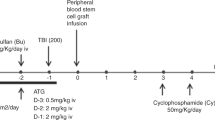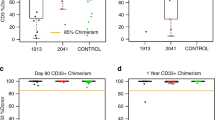Abstract
The purpose of this study was to determine the role of pre-emptive donor lymphocyte infusion (pDLI) after partial T-cell-depleted allogeneic SCT in patients with multiple myeloma (MM). A cohort of 24 MM patients was treated with partial T-cell-depleted myeloablative SCT between December 1997 and April 2002. These patients were intended to receive pDLI after SCT. The overall response rate after SCT was 83% (20 of 24 patients) with 10 patients (42%) in complete remission (CR). Transplant-related mortality within 1 year after SCT was 29%. Thirteen patients (54%) received pDLI and four patients in partial remission reached CR. GVHD>grade I after pDLI developed in 4 out of 13 patients (30%). Four patients received therapeutic DLI, without preceding pDLI. Eleven patients (46%) are alive, with a median follow-up of 67 months (range, 48–100 months). Seven of these patients (29%) are in continuous CR (CCR), which was confirmed by a negative patient-specific IgH PCR in four patients. All seven patients in CCR received pDLI. Although myeloablative SCT in MM induces high toxicity, we show that the concept of T-cell depletion followed by pDLI is promising and needs to be investigated in a reduced-intensity conditioning setting.
This is a preview of subscription content, access via your institution
Access options
Subscribe to this journal
Receive 12 print issues and online access
$259.00 per year
only $21.58 per issue
Buy this article
- Purchase on Springer Link
- Instant access to full article PDF
Prices may be subject to local taxes which are calculated during checkout


Similar content being viewed by others
References
Lokhorst HM, Wu K, Verdonck LF, Laterveer LL, van de Donk NW, van Oers MH et al. The occurrence of graft-versus-host disease is the major predictive factor for response to donor lymphocyte infusions in multiple myeloma. Blood 2004; 103: 4362–4364.
Zeiser R, Bertz H, Spyridonidis A, Houet L, Finke J . Donor lymphocyte infusions for multiple myeloma: clinical results and novel perspectives. Bone Marrow Transplant 2004; 34: 923–928.
Schaap N, Schattenberg A, Bar B, Preijers F, van de Wiel van Kemenade E, de Witte T . Induction of graft-versus-leukemia to prevent relapse after partially lymphocyte-depleted allogeneic bone marrow transplantation by pre-emptive donor leukocyte infusions. Leukemia 2001; 15: 1339–1346.
Lokhorst HM, Segeren CM, Verdonck LF, van der Holt B, Raymakers R, van Oers MH et al. Partially T-cell-depleted allogeneic stem-cell transplantation for first-line treatment of multiple myeloma: a prospective evaluation of patients treated in the phase III study HOVON 24 MM. J Clin Oncol 2003; 21: 1728–1733.
Preijers FWMB, van Hennik PB, Schattenberg A, Ruijs P, Ploemacher RE, de Witte T . Counterflow centrifugation allows addition of appropriate numbers of T cells to allogeneic marrow and blood stem cell grafts to prevent severe GVHD without substantial loss of mature and immature progenitor cells. Bone Marrow Transplant 1999; 23: 1061–1070.
Bar BMAM, Schattenberg A, Mensink EJBM, Vankessel AG, Smetsers TFCM, Knops GHJN et al. Donor leukocyte infusions for chronic myeloid-leukemia relapsed after allogeneic bone-marrow transplantation. J Clin Oncol 1993; 11: 513–519.
Blade J, Samson D, Reece D, Apperley J, Bjorkstrand B, Gahrton G et al. Criteria for evaluating disease response and progression in patients with multiple myeloma treated by high-dose therapy and haemopoietic stem cell transplantation. Myeloma Subcommittee of the EBMT. European Group for Blood and Marrow Transplant. Br J Haematol 1998; 102: 1115–1123.
Willems P, Verhagen O, Segeren C, Veenhuizen P, Guikema J, Wiemer E et al. Consensus strategy to quantitate malignant cells in myeloma patients is validated in a multicenter study. Belgium–Dutch Hematology–Oncology Group. Blood 2000; 96: 63–70.
Corradini P, Cavo M, Lokhorst H, Martinelli G, Terragna C, Majolino I et al. Molecular remission after myeloablative allogeneic stem cell transplantation predicts a better relapse-free survival in patients with multiple myeloma. Blood 2003; 102: 1927–1929.
van de Donk NW, Kroger N, Hegenbart U, Corradini P, San Miguel JF, Goldschmidt H et al. Prognostic factors for donor lymphocyte infusions following non-myeloablative allogeneic stem cell transplantation in multiple myeloma. Bone Marrow Transplant 2006; 37: 1135–1141.
Crawley C, Lalancette M, Szydlo R, Gilleece M, Peggs K, Mackinnon S et al. Outcomes for reduced-intensity allogeneic transplantation for multiple myeloma: an analysis of prognostic factors from the Chronic Leukaemia Working Party of the EBMT. Blood 2005; 105: 4532–4539.
Kroger N, Perez-Simon JA, Myint H, Klingemann H, Shimoni A, Nagler A et al. Relapse to prior autograft and chronic graft-versus-host disease are the strongest prognostic factors for outcome of melphalan/fludarabine-based dose-reduced allogeneic stem cell transplantation in patients with multiple myeloma. Biol Blood Marrow Transplant 2004; 10: 698–708.
Peggs KS, Thomson K, Hart DP, Geary J, Morris EC, Yong K et al. Dose-escalated donor lymphocyte infusions following reduced intensity transplantation: toxicity, chimerism, and disease responses. Blood 2004; 103: 1548–1556.
Meyer RG, Britten CM, Wehler D, Bender K, Hess G, Konur A et al. Prophylactic transfer of CD8-depleted donor lymphocytes after T-cell-depleted reduced-intensity transplantation. Blood 2007; 109: 374–382.
Kroger N, Shimoni A, Zagrivnaja M, Ayuk F, Lioznov M, Schieder H et al. Low-dose thalidomide and donor lymphocyte infusion as adoptive immunotherapy after allogeneic stem cell transplantation in patients with multiple myeloma. Blood 2004; 104: 3361–3363.
Alyea E, Weller E, Schlossman R, Canning C, Webb I, Doss D et al. T-cell-depleted allogeneic bone marrow transplantation followed by donor lymphocyte infusion in patients with multiple myeloma: induction of graft-versus-myeloma effect. Blood 2001; 98: 934–939.
Gahrton G, Svensson H, Cavo M, Apperly J, Bacigalupo A, Bjorkstrand B et al. Progress in allogenic bone marrow and peripheral blood stem cell transplantation for multiple myeloma: a comparison between transplants performed 1983–93 and 1994–8 at European Group for Blood and Marrow Transplantation centres. Br J Haematol 2001; 113: 209–216.
Kroger N, Einsele H, Wolff D, Casper J, Freund M, Derigs G et al. Myeloablative intensified conditioning regimen with in vivo T-cell depletion (ATG) followed by allografting in patients with advanced multiple myeloma. A phase I/II study of the German Study-group Multiple Myeloma (DSMM). Bone Marrow Transplant 2003; 31: 973–979.
Baron F, Storb R . Allogeneic hematopoietic cell transplantation following nonmyeloablative conditioning as treatment for hematologic malignancies and inherited blood disorders. Mol Ther 2006; 13: 26–41.
Garban F, Attal M, Michallet M, Hulin C, Bourhis JH, Yakoub-Agha I et al. Prospective comparison of autologous stem cell transplantation followed by dose-reduced allograft (IFM99-03 trial) with tandem autologous stem cell transplantation (IFM99-04 trial) in high-risk de novo multiple myeloma. Blood 2006; 107: 3474–3480.
Bruno B, Rotta M, Patriarca F, Mordini N, Allione B, Carnevale-Schianca F et al. A comparison of allografting with autografting for newly diagnosed myeloma. N Engl J Med 2007; 356: 1110–1120.
Author information
Authors and Affiliations
Corresponding author
Rights and permissions
About this article
Cite this article
Levenga, H., Levison-Keating, S., Schattenberg, A. et al. Multiple myeloma patients receiving pre-emptive donor lymphocyte infusion after partial T-cell-depleted allogeneic stem cell transplantation show a long progression-free survival. Bone Marrow Transplant 40, 355–359 (2007). https://doi.org/10.1038/sj.bmt.1705742
Received:
Revised:
Accepted:
Published:
Issue Date:
DOI: https://doi.org/10.1038/sj.bmt.1705742
Keywords
This article is cited by
-
Induction of multiple myeloma-reactive T cells during post-transplantation immunotherapy with donor lymphocytes and recipient DCs
Bone Marrow Transplantation (2012)
-
Role of allogeneic stem cell transplantation in multiple myeloma
Current Hematologic Malignancy Reports (2008)



